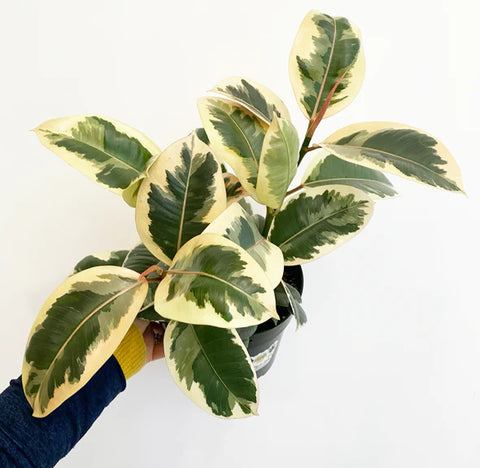Ficus Plant Care Guide
HOW TO GROW AND CARE FOR FICUS
By Julianne Blackaby | 25/09/2023

📷 Ficus Burgundy, Chalet Boutique
|
Common Varieties |
Ficus lyrata (Fiddle Leaf Fig), Ficus benjamina (Weeping Fig), Ficus elastica (Rubber Plant), Ficus pumila (Creeping Fig), Ficus microcarpa (Indian Laurel), Ficus benghalensis (Banyan Tree), Ficus retusa (Ginseng Ficus), Ficus Audrey, Ficus Lyrata Compacta, Ficus Alii (Amstel King), and Ficus maclellandii (Alii Fig). |
|
Botanical Name |
Ficus spp. |
|
Family |
Moraceae |
|
Plant Type |
Trees, shrubs, or houseplants, depending on the species. |
|
Mature Size |
Varies significantly by species, ranging from a few feet for houseplant varieties to large trees that can reach over 30 meters in height in their natural habitat. |
|
Light |
Bright, indirect light for most varieties, but some can tolerate lower light conditions. Avoid direct sunlight, especially for indoor Ficus plants. |
|
Soil Type |
Chunky aroid mix |
|
Native Areas |
Tropical and subtropical regions in Asia, Africa, Australia, and the Americas. |
|
Toxicity |
Ficus plants may be toxic to dogs and cats if ingested, primarily due to the presence of irritant sap. It's important to keep them out of reach of pets. |
Ficus is a species of flowering plant in the mulberry family, Moraceae, native to tropical and subtropical regions of the world. Ficus is one of the most popular houseplants in homes and offices worldwide. Ficus plants are highly versatile and can grow quite large, making them an excellent choice for larger spaces. Ficus plants have broad, glossy green leaves that can be either oval or pointed, depending on the species. They also produce an abundance of aerial roots and small, fig-like fruits. Ficus plants are relatively low-maintenance, requiring little more than regular watering, occasional pruning, and a bright, indirect light source. Ficus plants are also known for their air-purifying abilities, which can help improve the air quality of your home or office.
Our guide will provide all the information you need to keep your Ficus healthy and content, including tips on light and temperature needs, watering and fertilising, and how to propagate your plant. Let's embark on the journey of Ficus plant care together!
WELCOME TO YOUR COMPLETE GUIDE TO CARING FOR FICUS

HOW MUCH LIGHT DOES A FICUS NEED?
Ficus plants need bright, indirect light to thrive. They can tolerate direct sunlight but should not be placed in direct sun for more than a few hours daily. In the summer, outdoor shade is ideal. When indoors, bright artificial lighting should be supplemented to provide enough light for the plant. The Ficus should receive at least four hours of bright, indirect sunlight daily, but more is recommended. If you notice the leaves turning yellow or dropping off, it's a sign that the plant isn't receiving enough light.
HOW OFTEN SHOULD I WATER A FICUS?
It is essential to provide the right amount of water to your Ficus plant to keep it healthy. The amount of water needed depends on the environment and the size of the pot. Generally, the soil should be kept moist but not soggy. For most Ficus plants, water thoroughly once weekly, allowing the top 3-5cm of soil to dry out between waterings. The soil may need to be watered more frequently during the summer as the plant is actively growing. In the winter, water less often and allow the top layer of soil to dry out completely between waterings. It is essential to check the soil regularly to ensure the plant is not over or under-watered. Watering a Ficus during the winter is necessary to keep the plant healthy. Temperature is the most crucial factor when watering a Ficus in the winter. Because temperatures tend to be colder, the soil takes longer to dry out, so you should water less frequently than in the summer.
When you water, saturate the soil, allowing excess water to drain out of the pot. After watering, recheck the soil in a few days and repeat if necessary. Another tip is to use lukewarm water, as cold water can shock the plant and cause stress. Finally, monitoring your Ficus closely during the winter and adjusting your watering schedule is essential.

📷 Ficus Tineke, Chalet Boutique
WHAT IS THE BEST POTTING MEDIUM FOR FICUS?
The best potting medium for Ficus is a well-draining soil-based mix with a slightly acidic pH. Peat moss, perlite, and vermiculite are essential for a good potting mix. These ingredients are light and provide good drainage while holding enough moisture to keep the soil from drying out too quickly. Ensuring the potting mix is free of weed seeds, diseases, or insects is essential. A slow-release fertiliser will help ensure the Ficus has the proper nutrients to thrive. Lastly, a large pot with plenty of room for the roots to expand is recommended because Ficus can get quite large.
WHAT IS THE BEST TEMPERATURE FOR FICUS?
The best temperature for Ficus plants is between 15-22C. Ficus plants thrive in slightly cooler temperatures in the wintertime and slightly warmer temperatures in the summertime. They prefer the indirect light of a north, east, or west-facing window. It is best to keep Ficus away from cold drafts and direct sunlight. If the temperature drops below 15C, the leaves may drop off. If the temperature rises above 24C, the plant will suffer from too much heat and may begin to wilt. It is crucial to monitor your Ficus's temperature and ensure it is not getting too hot or too cold.
WHAT IS THE BEST HUMIDITY FOR FICUS?
The optimal humidity for a Ficus plant is between 50-60%. This is best achieved by having a relative humidity of 40-50% and a temperature of 15-22°C. If the temperature is too low, the plant will become stressed. If the temperature is too high, the plant will not be able to absorb enough moisture from the air. If the humidity is too low, the plant will suffer from dehydration, and the leaves will become dry and crispy. The plant may become susceptible to fungus and disease if the humidity is too high. It is important to note that Ficus plants are sensitive to changes in their environment, so it is essential to maintain a consistent temperature and humidity level for the plant to thrive.
TRAINING FICUS ONTO A TRELLIS
Ficus are easy to train onto a trellis or pole, and doing so can enhance their growth and appearance. Here are the steps you can follow to prepare your Ficus to grow onto a trellis or pole:
- Choose a sturdy trellis or pole tall enough to support the growing plant. The trellis should be made of a material the plant can easily attach itself to, such as bamboo or plastic.
- Position the trellis inside the pot, so it is directly in contact with the soil, ensuring it is stable and secure.
- Gently guide the plant's stems towards the trellis or pole, not damaging the leaves or roots.
- Use plant ties to attach the stems to the trellis or pole. Ensure the ties are not too tight and do not damage the stems.
- As the plant grows, guide its stems towards the trellis or pole and secure them with ties.
- Prune any stems not growing towards the trellis or pole, as this will encourage the plant to focus its energy on the trained stems.
- Water the plant regularly and fertilise it once a month to encourage healthy growth.
Following these steps, you can train your Ficus onto a trellis or pole, creating a beautiful and healthy plant to enhance any room or outdoor space.

WHAT IS THE BEST Fertiliser FOR FICUS?
We use Growth Technology, Foliage Focus for all our Tradescantias, here's why:
- Each GT Focus product is complete. Unlike the overwhelming majority of fertilisers, all Focus products contain each of the 12 essential minerals – including Calcium – blended into an easily absorbed liquid concentrate.
- pH buffered to ensure all 12 essential minerals are available to the plant.
- Formulated and balanced to suit the requirements of specific plant types.
- Manufactured using only the highest-grade raw materials and chelated trace elements to ensure effortless absorption by the plant.
- Guaranteed not to contain potentially harmful and ineffective chlorides, urea, sodium and ammonium.
- Easy to use with simple instructions.
- Makes up to 200 litres of working solution
WHAT ARE COMMON FICUS PESTS, AND HOW DO YOU TREAT THEM?
Ficus can be susceptible to various pests, including aphids, mealybugs, spider mites, and scale insects. The use of beneficial insects such as ladybugs, lacewings, and parasitic wasps can be effective biological control against these pests.
Aphids are small, soft-bodied insects that feed on plant juices. They can be identified by their pear-shaped bodies, usually black, green, yellow, or brown. Aphids can weaken the plant by sucking out its sap, leading to yellowing and/or wilting leaves. Treatment for aphids includes spraying the plant with a strong water stream or using an insecticidal soap or neem oil solution.
Mealybugs are small, white, fuzzy insects that feed on plant sap. They are usually found in clusters on the underside of the leaves. Mealybugs can be treated with insecticidal soap, neem oil, or a cotton swab dipped in rubbing alcohol to wipe them off.
Scale insects are tiny, flat, oval-shaped pests that feed on plant sap. They can also be identified by the white, waxy coating they produce. Treatment for scale insects includes wiping them off with a cotton swab dipped in rubbing alcohol or spraying the plant with neem oil.
Spider mites are tiny, eight-legged arachnids that feed on plant sap. They cause yellowing and stippling of the leaves and webbing on the foliage. Treatment for spider mites includes spraying the plant with Kill-a-mite or Stealth. By monitoring these common pests and treating them promptly, you can ensure your plant stays healthy and thrives.

Top Left: Aphids, Top Right: Scale, Middle: Mealybugs, Bottom: Spidermites
HOW TO PRUNE A FICUS
Pruning a Ficus indoor plant is a relatively easy task. The first step is to identify any dead or damaged leaves and branches. Using a pair of sharp, clean pruning shears, trim just above the damaged area so the plant is not left with an exposed wound. Once all the dead or damaged leaves have been removed, it is time to shape the plant. Prune any branches growing too long or competing with other branches. Ensure enough foliage for the plant to produce new growth and trim the excess. After all of the trimmings are complete, clean the pruning shears with rubbing alcohol and dispose of the clippings in a compost bin or green waste bin.
HOW TO PROPAGATE A FICUS
Propagating a ficus is a relatively simple process. First, choose a healthy stem with at least 3-4 well-developed leaves. Cut the stem below a leaf node using a sharp and clean pair of scissors. Then, dip the end of the stem into a rooting hormone powder to encourage root growth. Once the stem has been coated, plant it in a pot filled with well-draining soil and water it immediately. Keep the soil moist but not soggy, and place the pot in a warm, bright spot where it will receive indirect sunlight. After a couple of weeks, you should see new growth on the stem, which signifies that the Ficus is rooting. Once rooted, you can transplant it into a larger pot and begin caring for it like an adult Ficus.
WHEN DO YOU NEED TO REPOT A FICUS?
Repotting a Ficus is necessary if the roots have become too large for the container. You will know this is the case if the plant is root-bound, meaning the roots grow in circles and fill the container. Repotting is also recommended if the plant is not getting enough water or nutrients or has been in the same pot for more than two years. You should also consider repotting if the Ficus looks droopy or has become too large for its current location. Repotting a Ficus is a simple process that requires transferring the plant from its container to a larger container with fresh potting soil. Remember to choose a container with drainage holes when repotting a Ficus, as Ficus trees do not like waterlogged.

📷 Ficus lyrata - Fiddle Leaf Fig, Chalet Boutique
WHAT SORT OF POT DOES A FICUS NEED?
Ficus plants prefer slightly acidic soil that is well-draining and nutrient-rich. A good potting mix for these plants consists of a combination of potting soil, sand, and composted organic matter. Using a pot with a drainage hole is essential, as Ficus plants do not like to sit in waterlogged soil. They also prefer a larger pot, allowing their roots to spread and giving them room to grow. When selecting a pot, ensure it is wide and deep enough to accommodate the Ficus's root system.
HOW DO YOU GET A FICUS TO BLOOM?
Providing the right environment and proper care is vital to get a Ficus to bloom. First, make sure the location is bright but not too sunny. Ficus plants prefer indirect sunlight, so a spot near a window is ideal. Next, water the plant when the soil is dry. Ficus plants require frequent watering but not too much - avoid over-watering. Additionally, fertilise it monthly with a balanced fertiliser. Finally, prune the plant regularly to encourage new growth and blooms. As for the type of pot, Ficus plants prefer a shallow plastic container with drain holes. This helps to keep the roots from becoming waterlogged and promotes better air circulation.
ARE FICUS TOXIC TO PETS AND CHILDREN?
Many Ficus species, including the Ficus benjamina (Weeping Fig) and Ficus elastica (Rubber Plant), can be mildly toxic to pets and children. The sap and latex produced by these plants can cause irritation if ingested or come into contact with the skin.
Common symptoms of ingestion may include drooling, vomiting, or gastrointestinal discomfort in pets or children. Skin contact with the sap can sometimes lead to skin irritation or dermatitis.
To prevent potential issues, it's advisable to keep Ficus plants out of reach of pets and children. If you suspect ingestion or skin contact, it's best to consult with a medical professional or veterinarian for guidance on how to address the specific situation.
A List of Well Known Ficus Indoor Plants
- Ficus lyrata (Fiddle Leaf Fig)
- Ficus benjamina (Weeping Fig)
- Ficus elastica (Rubber Plant)
- Ficus microcarpa (Indian Laurel)
- Ficus benghalensis (Banyan Tree)
- Ficus retusa (Ginseng Ficus)
- Ficus Audrey
- Ficus Lyrata Compacta
- Ficus Alii (Amstel King)
- Ficus maclellandii (Alii Fig)
